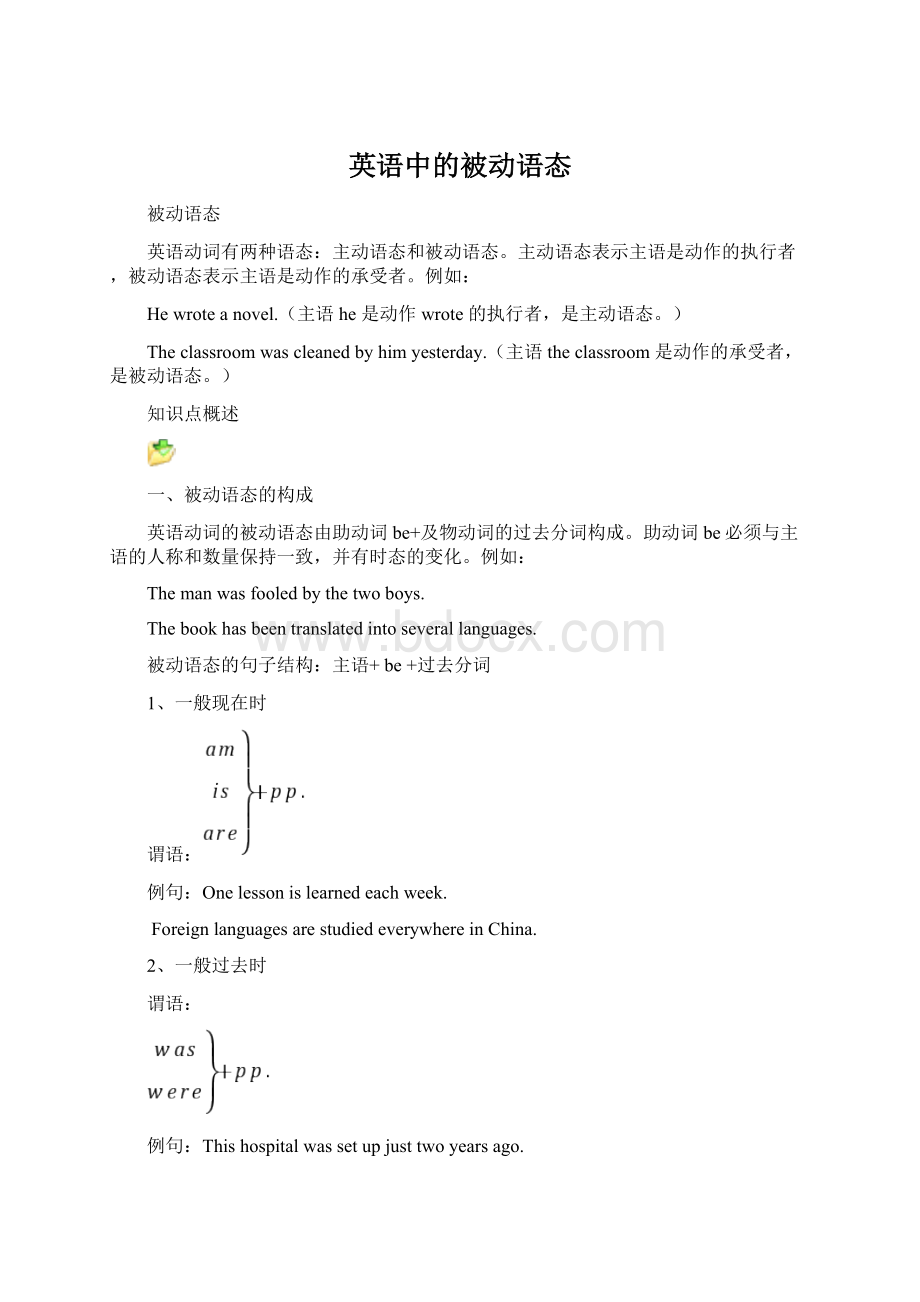英语中的被动语态Word下载.docx
《英语中的被动语态Word下载.docx》由会员分享,可在线阅读,更多相关《英语中的被动语态Word下载.docx(14页珍藏版)》请在冰豆网上搜索。

5、现在完成时
Ashasbeenpointedout,thehousingprobleminourdistricthasbasicallybeensolved.
6、过去完成时
hadbeen+pp.
WhenIgottotheticketoffice,alltheticketshadbeensoldout.
7、现在进行时
Thepatientsinward12arebeingtakencareofbyMissHoover.
8、过去进行时
Shesaidherhousewasbeingpainted.
注:
及物的短语动词相当于一个及物动词,可以有被动语态,这类短语动词有:
turnon,turnoff,findout,laughat,lookafter,talkabout,thinkof/aboutover,bringabout,(引起;
导至)putaway,makeout(认出),makeup(编;
补尝),lookdownupon,
payattentionto,faceupto(面对)
二、被动语态的用法
(1)动作的执行者不知道是谁或难以说明时常用被动语态。
Streetlightsareoftenturnedonatsixinwinter.
Thenewtestbookwillbeusednextterm.
(2)当动作的承受者比起动作的执行者来说更能引起人们的关心而需要加以强调时,要用被动语态。
Thiskindofbicycleisnotsoldinourshop.
Thethiefwascaughtbyapolicemanyesterday.
(3)含有双宾语的句子,主动句中的间接宾语或者直接宾语都可变为被动语态中的一个主语,另一个保留不变。
变为主语的若是主动句中的直接宾语在变为间接宾语前则需加介词to或for。
Thepianistgavethepupilssomeadvice.
间接宾语直接宾语
→Thepupilsweregivensomeadvicebythepianist.
→Someadvicewasgiventothepupilsbythepianist.
(4)在主动语态句中动词make、have、let、see、watch、hear、feel等后接动词不定式作宾语补足语,动词不定式不加to。
但变成被动语态时后面的不定式都须加上to。
Thebossmadethemworktenhoursaday.
→Theyweremadetoworktenhoursaday.
Aboysawhimenterthehouse.
→Hewasseentoenterthehouse.
三、被动语态的时态
初中英语教材中出现了五种时态的被动语态及带有情态动词的被动语态。
(1)一般现在时
构成:
助动词be+动词的过去分词
Thiskindofcarismadeinshanghai.
Englishisspokeninmanycountries.
(2)一般过去时
助动词was/were+动词的过去分词
Thebridgewasbuiltin1992.
Wasthisnovelwrittenbyhisfather?
(3)一般将来时
will/begoingtodo+be+动词的过去分词
Thesebooksaregoingtobepostedtomorrow.
Thebabywillbetakengoodcareofinthehospital.
(4)现在完成时
助动词have/has+been+动词的过去分词
Hashisworkbeenfinished?
Wehaven’tbeeninvitedtotheparty.
(5)现在进行时
be+being+动词的过去分词
Anewbridgeisbeingbuiltinmyhometown.
Theproblemisbeingdiscussedbythestudents.
(6)带有情态动词的被动语态
情态动词+be+动词的过去分词
Canthiswalkmanberepairedhere?
Yourcompositionmustbehandedintomorrow.
二、复习时需要注意的要点
(1)由主动语态改为被动语态的步骤:
主动语态中的宾语变为被动语态句中的主语;
主动语态句中的动词改为相应的被动语态;
主动语态句中的主语变为被动语态句中by的宾语。
(2)主动语态句中的谓语动词带有双宾语,即直接宾语和间接宾语时,转换方法有两种:
把间接宾语转化为主语,保留直接宾语
把直接宾语转化为主语,保留间接宾语。
此时,一般需在间接宾语前加适当的介词。
(3)在短语seesb.dosth.中,动词see后跟不带to的不定式作宾补。
改为被动语态时要加上to。
用于这一结构的谓语动词一般是表示知觉的动词如see,hear等,以及使役动词make,let等。
实战演练
一、例题选讲
例1
Jack(be)inhospitalnow.He(send)thereyesterday.
答案:
Is,wassent
提示:
由于now表示的是现在,会想到用现在进行时,而这里的动词be表示状态,不能用进行时,句子的主语he是动作的承受者,要用被动语态。
例2
Macao(return)toChinaonDecember20,1999.
returned
本句有一个明确的时间状语,要用一般过去时。
句意是“1999年12月20日澳门回归祖国”。
return既可作及物动词,也能作不及物动词。
由于本句立足于“澳门在1999年回归”,不强调“由谁归还”这一动作,所以一般用主动语态。
例3
Mybike(move)awayfromthisside.Iaskedthemanwhythis(do).
hasbeenmoved,hadbeendone
第一句主要陈述此事与现在有关,用现在完成时,第二句从句中的动作发生在主句前,主句用一般过去时,从句要用过去完成时。
这两句中的动作均有被动意义,要用被动语态。
例4
Alotofwater(waste)everyday.It’saseriousproblem
iswasted
表示每天都如此的习惯性状态,用一般现在时,水是“被浪费的”,要用被动语态。
例5
Whenwetclothesarehungupnearafire,steamcansoonbeseen(rise)fromthem.
rising
这道题是被动语态,要求用非谓语动词作主语补足语,现在分词和动词不定式都是非谓语动词,两者都可以作宾语补足语或主语补足语,但用法不同。
现在分词作补语时,表示动作正在进行。
此句是表示水蒸气正在从湿衣服上升起,用现在分词表示。
例6
Astrangemanwasseen(enter)theofficetenminutesago.
toenter
这道题也是被动语态,要求用非谓语动词形式填空。
用动词不定式作补语表示动作的全过程。
句中的“进入”,是十分钟前看到的动作的全过程,用不定式表示。
在主动句中省略“to”,在被动句中要加“to”。
一般现在时的被动语态
英语语态有主动语态和被动语态两种。
主语是动作的执行者,叫主动语态。
如:
Wecleantheclassroom.我们打扫教室。
主语是动作的承受者,叫被动语态。
Theclassroomiscleaned(byus).教室被(我们)打扫。
1.被动语态的构成:
助动词be+及物动词的过去分词+(by+宾语)
其中by意为“被……;
由……”,表动作的执行者。
Theglassisbrokenbythatboy.玻璃杯是那个男孩打破的。
be有人称、数和时态的变化,其肯定式、否定式、疑问式的变化规则与be作为连系动词时完全一样。
Englishiswidelyspokenaroundtheworld.(肯定式)
Englishisnotwidelyspokenaroundtheworld.(否定式)
IsEnglishwidelyspokenaroundtheworld?
(疑问式)
Yes,itis./No,itisn’t.
2.被动语态的用法:
(1)在没有指明动作的执行者或者不知道动作执行者的情况下,可用被动语态。
Thiscoatismadeofcotton.这件大衣是棉制的。
(2)要强调动作的承受者而不是执行者时,用被动语态。
Herbikeisstolen.她的自行车被偷了。
3.主、被动语态的转换:
主动语态:
主语+及物动词谓语动词+宾语(+其它)
被动语态:
主语+be+及物动词的过去分词+by+宾语(+其它)
注意:
(1)主动、被动互转时,时态不变。
(2)主动句的主语是代词的主格形式,变成被动态by的宾语时,要用宾格形式。
(1)
Peoplegrowriceinthesouth.Riceisgrown(bypeople)inthesouth.
(2)
Shetakescareofthebaby..Thebabyistakencareof(byher).
动词一般过去式的构成
a.规则动词过去式的变化可速记为直、去、双、改四字诀。
①一般情况下在动词原形后直接加-ed。
wanted,played。
②以不发音的字母e结尾的动词,去掉e再加-ed。
hoped,lived。
③重读闭音节单词需双写最后一个辅音字母再加-ed。
stopped。
④以辅音字母+y结尾的动词变y为i,再加-ed。
studied,worried。
不规则动词过去式和过去分词
A.原形与过去式和过去分词完全相同.
cost----cost----costcut----cut----cut
put----put----putset----set----set
let----let----lethit----hit----hit
shut----shut----shuthurt---hurt----hurtread---read----read读音/e/
其他:
lie---lied---lied说谎lay---laid---laid放置,下蛋
lay---lain躺下,位于,平放
eg.Thehensdon’t_______eggsduringsuchcoldweather.
She_____herbooksonthetable.____
B.过去式与过去分词完全相同
1.过去式和过去分词中含有ought,aught,读音是〔:
t〕
bright----brought----broughtthink----thought----thoughtbuy----bought----bought
catch----caught----caughtteach----taught----taught
2.动词原形中的e为o,变成过去式和过去分词。
get----got----gotsell----sold----soldtell----told----told
3.动词原形中i为a,…
sit----sat----satspit----spat----spat
4.动词原形中i为o,…
win----won----won
shine----shone/shined----shone/shined
5.动词原形中an为oo,…stand----stood---stoodunderstand----understood----understood
6.动词原形中的ay为ai,…
say----said----saidpay----paid----paid
7.a)动词原形中的d为t,…
send----sent----sentlend----lent----lent
spend----spent----spentbuild----built----built
b)动词原形最后一个字母改为t,…smell----smelt----smeltlose----lost----lost
c)动词原形后加一个字母t,…learn----learnt----learntmean----meant----meant读音/e/
d)动词原形中的ee去掉一个字母e,然后在词尾加t.字母e发音/e/
feel----felt----feltsleep----slept----sleptsweep---swept----swept
keep----kept-----kept
其它meet----met----methave----had----hadhold----held----held
make----made----madedig----dug----dughear----heard----heard
find----found----foundhang----hung----hung
C.原型与过去分词相同
come----came----comerun----ran----runbecome----became----become
D.原形,过去式和过去分词完全不同
1.把动词原形中i改为a变成过去式,改成u变成过去分词.
begin----began-----begundrink---drank----drunkring----rang-----rung
swim----swam----swumsing----sang----sung
2.把动词原形中o改为e变成过去式,在原形词尾加n变成过去分词.
blow----blew----blowngrow----grew----grownknow---knew---known
throw----threw----thrownfly----flew/flu:
/----flown(和以上相似)
3.以下动词的过去分词都以en结尾,故把它们分为一类.
a)把动词原形中i改为o变成过去式,在词尾加n变成过去分词.
drive----drove----drivenrise---rose---risenwrite---wrote---written(双写t)
ride----rode----ridden(双写d)
b)把动词原形中ea改为o,在词尾加e变成过去式,在过去式后加n变成过去分词.
speak----spoke----spokensteal----stole----stolenbreak----broke----broken
c)把动词原形中的个别字母或字母组合改为o变成过去式,在过去式后加n变成过去分词.
wake----woke----wokenfreeze----froze----frozen
choose----chose----chosenforget----forgot----forgotten(双写t,加—en)
d)其它过去分词以en结尾的动词
eat----ate----eatenbeat----beat----beatenfall----fell----fallen
give----gave----givensee----saw----seentake----took----taken
mistake----mistook-----mistakenhide----hid----hidden(双写
E.没有过去分词的动词
can-----couldmay----mightshall----shouldwill----would
其它
am,is----was-----beenare-----were-----been
do-----did-----done
draw-----drew-----drawngo-----went-----goneshow----showed----shown
Wear----wore----worn
三、练习
Ⅰ.把下列主动语态改为被动语态:
1.WeoftenusearecorderinourEnglishclass.
2.Theywillshowanewfilmnextweek.
3.Whendidtheybuildthehouse?
4.Isawtheboyentertheroom.
5.Willtheyshowanewfilmnextweek?
6.Havetheypostedtheletteryet?
7.Weoftenseehimhelphisclassmate.
8.Youmustturnoffthelightbeforeyougotobe.d
9.Whoisrepairingthebike?
10.Thestudentshouldlearnallthetextsbyheart.
Ⅱ.选择填空:
1.Thereadingroom________yesterdayafternoon.
A.cleanedB.iscleanedC.wascleaningD.wascleaned
2.Theworkersweremade________tenhoursaday.
A.workB.toworkC.workingD.worked
3.Food________inacoolplaceinsummer.
A.mustkeepB.mustn’tkeepC.mustbekeptD.mustn’tbekept
4.Hisfather________toworkinHongKong3yearsago.
A.sentB.wassentC.hassentD.hasbeensent
5.Thepen________well.
A.writesB.iswrittenC.waswrittenD.writing
6.Greatchanges________inthetownsince1988.
A.havetakenplaceB.havebeentakenplace
C.hastakenplaceD.hasbeentakenplace
7.Ourcompositionsmust________nextMonday.
A.behandinB.behandedinC.handedinD.behandingin
8.Thechildwill________backtohisparentsnextmonth.
A.sentB.sendC.besentD.besending
9.________hiswork________yet?
A.have…beenfinishedB.has…beenfinished
C.has…finishedD.have…finished
10.Theclassroom________now
A.iscleaningB.isbeingcleaning
C.isbeingcleanedD.iscleaned
Ⅲ.用适当时态和语态的动词填空:
1.Canhe________(speak)English?
2.Whatlanguage________(speak)inthatcountry?
3.Thefilm________(show)manytime